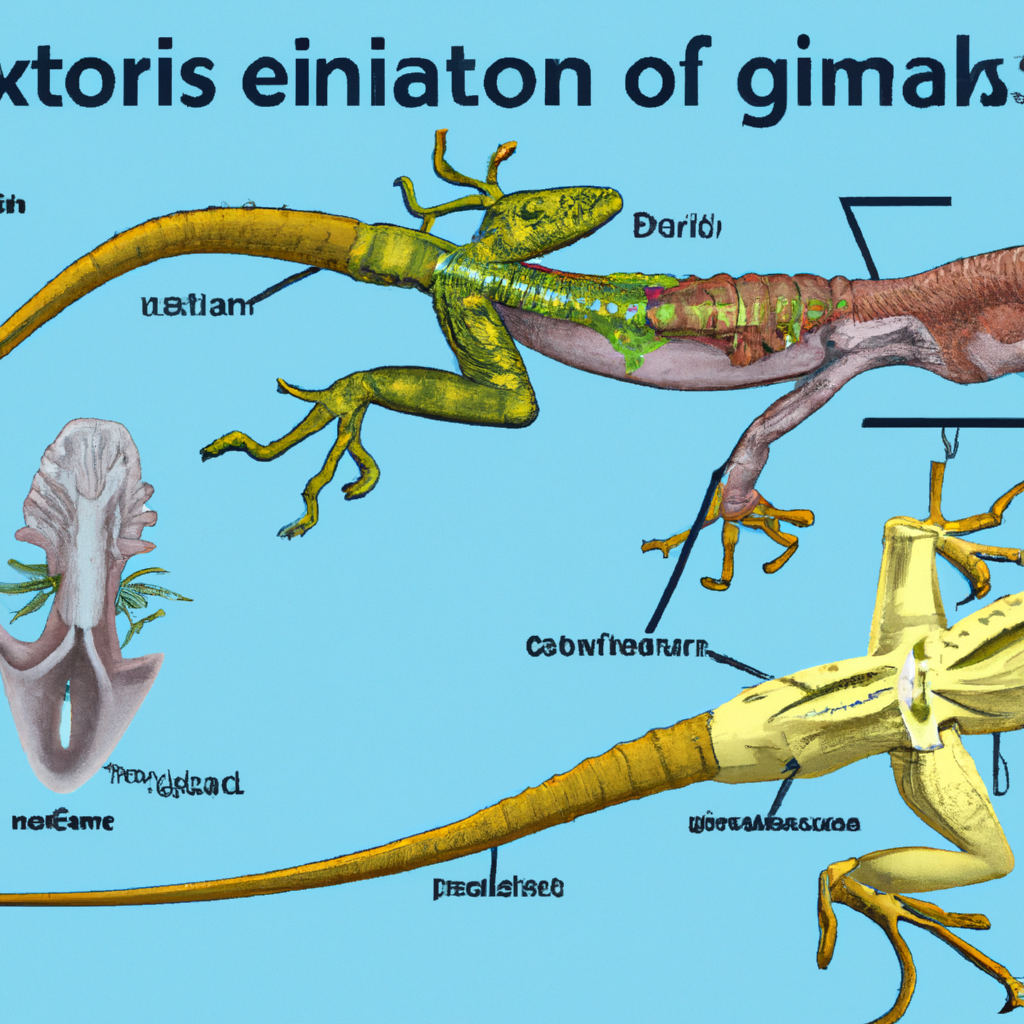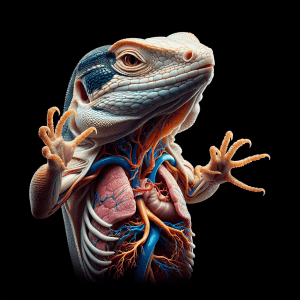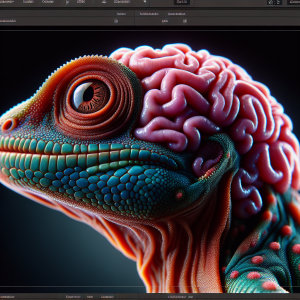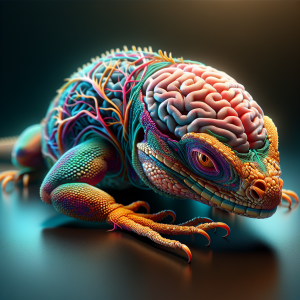Introduction to Lizard Anatomy
Lizard anatomy is a fascinating and complex subject that delves into the physical structure and biological systems of one of the most diverse groups of reptiles on the planet. Lizards belong to the order Squamata, which also includes snakes and amphisbaenians. With over 6,000 species spread across various habitats around the world, lizards exhibit a remarkable range of forms and sizes, from the minuscule geckos to the formidable Komodo dragons.
The study of lizard anatomy not only provides insights into their survival strategies and evolutionary history but also enhances our understanding of vertebrate biology as a whole. Lizards have adapted to an array of environments, and their bodies reflect the ecological niches they occupy. For instance, some species have developed elongated bodies and reduced limbs to navigate through sand or leaf litter, while others boast robust limbs and sharp claws for climbing.
At the core of lizard anatomy are the fundamental components that define their existence as reptiles: dry, scaly skin that aids in water retention; ectothermic metabolism, which relies on external heat sources for body temperature regulation; and a vertebral column that supports their structure and allows for mobility. These reptiles also possess a tail, which can serve various functions such as balance, defense, and fat storage.
Internally, lizards are equipped with organ systems that are both unique and analogous to other vertebrates. They have a heart that pumps blood through their circulatory system, lungs for respiration, and a digestive tract that processes their diverse diets. Additionally, their reproductive systems can vary greatly, with some species laying eggs while others give live birth.
Understanding lizard anatomy is not only crucial for herpetologists and biologists but also for veterinarians, conservationists, and reptile enthusiasts. By exploring the intricacies of their anatomy, we can appreciate the evolutionary marvels these creatures represent and the vital roles they play in our world’s ecosystems.
Overview of Lizard External Features
Lizards, a diverse group of reptiles, exhibit a wide array of external features that not only contribute to their distinctive appearance but also play crucial roles in their survival. One of the most prominent characteristics of lizards is their skin, which is covered in tough, overlapping scales. These scales are made of keratin, the same material that forms human hair and nails, and serve to protect the lizard from environmental hazards, prevent water loss, and sometimes even aid in camouflage.
The head of a lizard is typically adorned with a set of sharp eyes, which grant them excellent vision, including the ability to detect movement from long distances. Many species also have the ability to see a broad spectrum of colors, which is essential for identifying food, mates, and threats. Additionally, some lizards, like chameleons, can move their eyes independently, allowing them to observe two different directions simultaneously.
Lizards possess limbs that vary greatly among species, from the well-developed legs of iguanas and geckos to the reduced or absent limbs of snakes’ close relatives, like the slow worm. The structure of their limbs is closely related to their habitat and lifestyle; for instance, arboreal lizards often have long, grasping toes for climbing, while burrowing species may have spade-like feet for digging.
The tail is another significant external feature, which can serve multiple functions. In many species, the tail acts as a fat storage reserve, a counterbalance during movement, and a defensive mechanism. Some lizards can even detach their tails when threatened—a process known as autotomy—allowing them to escape predators while the discarded tail continues to wriggle, creating a distraction.
Lastly, the eyes, ears, and mouth of lizards are adapted to their specific diets and environments. Sharp teeth or strong jaws enable them to capture and consume a variety of prey, while their ears, often just small openings, are sensitive enough to detect the subtle vibrations of an approaching threat or potential meal. Together, these external features form a complex and efficient system that enables lizards to thrive in diverse habitats around the world.
The Skeletal System of Lizards
The skeletal system of lizards is a marvel of evolutionary engineering, providing both support and flexibility to these diverse reptiles. Lizards belong to the class Reptilia and the order Squamata, which also includes snakes. Their skeletal structure is adapted to a wide range of habitats and lifestyles, from climbing trees to burrowing underground.
At the core of a lizard’s anatomy is the axial skeleton, which consists of the skull, vertebral column, ribs, and sternum. The skull of lizards is particularly notable for its kinetic ability – many species have skulls with joints that allow them to move the upper jaw independently of the braincase and lower jaw. This adaptation aids in the capture and consumption of prey, allowing lizards to consume larger items.
The vertebral column is divided into several regions: cervical (neck), thoracic (chest), lumbar (abdomen), sacral (pelvic), and caudal (tail) vertebrae. The number of vertebrae in each region can vary greatly among different lizard species, influencing their flexibility and mobility. For instance, species with longer tails have more caudal vertebrae, which can be shed and regenerated in some species as a defense mechanism known as autotomy.
Lizards also possess a well-developed appendicular skeleton, which includes the bones of the limbs. The pectoral (shoulder) and pelvic (hip) girdles anchor the limbs to the axial skeleton. The limb bones are connected by joints, which provide the range of motion necessary for locomotion. In some species, like the geckos, the digits have evolved to have adhesive pads, allowing them to climb smooth vertical surfaces.
The ribcage of lizards is not as rigid as in mammals, allowing for greater flexibility. This flexibility is crucial for respiration, as lizards typically lack a diaphragm. Instead, they rely on the movement of their ribs to facilitate lung expansion and contraction.
Overall, the skeletal system of lizards is a testament to their adaptability and survival, showcasing a range of features that support their varied ecological niches. From the kinetic skull to the regenerative tail, each aspect of their skeletal anatomy plays a vital role in their daily existence and evolutionary success.
Lizard Anatomy Musculature and Movement
Lizards are remarkable creatures, showcasing a wide array of movements that are supported by their specialized musculature. The muscular system of lizards is both complex and efficient, allowing these reptiles to perform actions ranging from rapid sprints to precise maneuvers.
The muscles in a lizard’s body are divided into several groups, each with its specific function. The axial muscles, which include the muscles along the spine, are primarily responsible for the lateral undulation that propels many lizard species forward. This undulating movement is particularly evident in species like the common skink, where the body bends into sinuous waves, allowing for swift and agile motion.
Limb muscles are another critical group, providing the strength and control necessary for activities such as climbing, digging, and grasping. The forelimbs and hindlimbs of lizards are equipped with powerful flexor and extensor muscles, which work in opposition to each other to create movement. For instance, when a gecko scurries up a vertical surface, its limb muscles work in concert to adhere to and push off from the substrate with remarkable precision.
Furthermore, the muscles of the tail play a vital role in lizard locomotion and balance. Many lizards, such as the green iguana, use their tails as a counterbalance when climbing or leaping, while others, like the basilisk, can even use their tails to aid in swimming. In some species, the tail can be a defensive tool, capable of delivering powerful whips to deter predators.
The unique musculature of lizards is also adapted for energy conservation. Many species exhibit a ‘sit-and-wait’ hunting strategy, where they remain motionless for extended periods, relying on sudden bursts of speed to catch prey. This ability to switch from a state of rest to high-speed action is a testament to the efficiency of their muscle fibers, which can rapidly generate force when required.
In summary, the musculature of lizards is a testament to evolutionary refinement, allowing these reptiles to navigate their environment with grace and power. From the smooth undulations of a skink to the adept climbing of a gecko, the muscular system of lizards is integral to their survival and success in a diverse range of habitats.
The Respiratory System in Lizards Anatomy
Lizards, as ectothermic reptiles, possess a respiratory system that is both efficient and adapted to their varied lifestyles. Unlike mammals, lizards do not rely on a diaphragm to breathe; instead, they employ other muscles around their rib cage to expand and contract their lungs.
The basic structure of the lizard respiratory system includes a pair of lungs that are often asymmetric in size and shape. This asymmetry is particularly pronounced in species like the chameleon, where the body shape necessitates a different lung configuration. The larger lung is typically more developed and may have a greater number of internal partitions, known as faveoli, which increase the surface area for gas exchange.
Lizards breathe in oxygen-rich air through their nostrils, which then passes through the glottis and into the trachea. The trachea bifurcates into two bronchi, leading to the lungs. Within the lungs, the bronchi further divide into smaller bronchioles that end in the faveoli. It is here that the exchange of oxygen and carbon dioxide takes place. Oxygen diffuses into the blood, while carbon dioxide diffuses out to be expelled with the next exhalation.
The efficiency of this system can vary among different lizard species. For instance, some lizards have the ability to increase their respiratory efficiency by buccal pumping, a process where they actively move air into their lungs using their throat muscles. This is particularly useful during periods of intense activity or when the lizard is under stress.
Moreover, certain adaptations have evolved in some lizard species to cope with their habitats. For example, aquatic lizards may have developed ways to hold their breath for extended periods, while desert-dwelling lizards often exhibit behaviors that minimize water loss through respiration.
Overall, the respiratory system of lizards is a testament to their adaptability and evolutionary success, allowing them to inhabit diverse environments and maintain the necessary oxygen supply for their metabolic needs.
Navigating the Lizard Digestive Process
The digestive system of lizards is a fascinating example of evolutionary adaptation, allowing these reptiles to efficiently process a wide variety of food sources. From the moment prey is captured, the lizard’s digestive journey begins with the mechanical breakdown of food in the mouth. Lizards have sharp teeth designed for seizing and holding onto their prey, rather than chewing. Some species have teeth that are specialized for their diet, such as the modified teeth of herbivorous lizards that help in tearing plant material.
Once the food is sufficiently processed in the oral cavity, it travels down the esophagus and enters the stomach. The lizard stomach is a muscular organ that uses both mechanical and chemical means to further break down the food. Gastric juices, rich in hydrochloric acid and digestive enzymes, work to dissolve and decompose the meal into a semi-liquid form known as chyme.
The chyme then moves into the small intestine, where the majority of nutrient absorption occurs. The walls of the small intestine are lined with villi, small finger-like projections that increase the surface area for absorption. Here, nutrients are transferred into the bloodstream to be distributed throughout the lizard’s body. The liver and pancreas play crucial roles in this process by secreting bile and digestive enzymes, aiding in the digestion of fats and further breakdown of carbohydrates and proteins.
Undigested material and waste products continue their journey into the large intestine, where water is reabsorbed, and the remaining waste is compacted into feces. The cloaca, a common exit cavity for the digestive, urinary, and reproductive systems, is the final stop before excretion.
Lizards’ digestive systems are highly efficient, reflecting their often opportunistic feeding habits and the need to maximize energy intake from their diet. This efficiency is particularly important for survival in the diverse environments lizards inhabit, from deserts to rainforests, showcasing the remarkable adaptability of these creatures.
The Circulatory System of Lizards Anatomy
The circulatory system of lizards is a vital network that ensures the distribution of nutrients, oxygen, and hormones throughout their body, while also playing a crucial role in temperature regulation and immune defense. This system is composed of the heart, blood vessels, and blood, functioning in a manner that is both similar to and distinct from other vertebrates.
At the heart of the lizard’s circulatory system is a three-chambered heart, consisting of two atria and one ventricle. Unlike mammals and birds that have a four-chambered heart, the lizard’s heart allows for some mixing of oxygenated and deoxygenated blood. However, a muscular ridge within the ventricle helps to reduce this mixing, ensuring a more efficient circulation than would be expected in a three-chambered heart. This adaptation is particularly important during periods of activity when the demand for oxygen increases.
The blood vessels include arteries, which carry blood away from the heart, and veins, which return it. Capillaries, the smallest blood vessels, are the sites of gas exchange and nutrient delivery to tissues. Lizards, like other reptiles, have a renal portal system, where blood from the hind limbs passes through the kidneys before returning to the heart. This unique feature allows for the adjustment of blood flow to the kidneys, which is essential for osmoregulation and waste removal.
Lizards have evolved various physiological adaptations to their circulatory systems to cope with their ectothermic nature. For instance, they can alter the flow of blood to the skin to aid in thermoregulation, expanding or constricting blood vessels to either increase or decrease heat loss. During basking, blood flow to the skin increases, facilitating the warming of the body, while in cooler environments, the flow is reduced to conserve heat.
The efficiency of the lizard’s circulatory system is also evident in their ability to survive significant blood loss, a common occurrence in predator-prey interactions where tail autotomy (self-amputation) can occur. The rapid constriction of blood vessels and clotting mechanisms minimize blood loss and facilitate survival.
In summary, the circulatory system of lizards is a complex and adaptive network that supports their survival in diverse environments. It is a testament to the evolutionary ingenuity that allows these reptiles to thrive in habitats ranging from deserts to rainforests.
Lizard Anatomy Reproductive Organs and Mating
The reproductive system of lizards is a fascinating aspect of their anatomy, showcasing a variety of adaptations that enable these reptiles to thrive in diverse environments. Lizards exhibit sexual dimorphism, meaning that males and females often have distinct physical characteristics associated with their sex, particularly in the structure of their reproductive organs.
Male lizards possess paired hemipenes, which are two reproductive organs located at the base of the tail. Unlike mammals, these structures are not used for the elimination of waste; they are solely for reproduction. The hemipenes are usually inverted within the body and everted during mating. Each hemipene has a series of grooves that help transport sperm to the female’s cloaca during copulation.
Females, on the other hand, have a cloaca, an all-purpose opening used for mating, laying eggs, or giving birth, as well as for excretion. Inside, females have ovaries where eggs are produced. Depending on the species, lizards can be oviparous (egg-laying) or viviparous (giving live birth). Oviparous lizards typically lay eggs with leathery shells in a safe, hidden location, while viviparous species have developed a placenta-like structure to nourish the embryos internally until birth.
The mating process begins with courtship behaviors, which can be quite elaborate and include visual displays, head-bobbing, and pheromone release. These behaviors serve to attract mates and signal the readiness to reproduce. Once a pair is formed, the male will approach the female and position himself to align his cloaca with hers, allowing for the transfer of sperm.
Lizard reproductive strategies are also influenced by environmental factors. Some species exhibit temperature-dependent sex determination, where the temperature at which the eggs are incubated determines the sex of the offspring. This unique adaptation underscores the intricate relationship between lizard anatomy and the ecosystems they inhabit.
Understanding lizard reproductive anatomy and mating rituals provides insight into the survival mechanisms of these reptiles, highlighting the complexity and diversity of life on Earth.
The Sensory Capabilities of Lizards Anatomy
Lizards possess a remarkable array of sensory capabilities that allow them to interact with their environment in unique ways. These reptiles rely heavily on their keen senses to hunt, avoid predators, and communicate with one another.
One of the most notable sensory organs in lizards is their eyes. Lizards typically have excellent vision, with some species capable of seeing colors beyond the human visible spectrum, including ultraviolet light. This heightened vision facilitates the identification of mates, since many lizards display UV-reflective patterns on their skin. Furthermore, their eyes can move independently, providing a wide field of view without the need to move their heads, which is crucial for detecting motion and spotting prey or predators.
In addition to their visual acuity, lizards have a highly developed sense of hearing. While they lack external ears, they have eardrums located on the surface of their heads, which can detect a range of sounds. This auditory ability helps them recognize the calls of potential mates or the warning signals of other lizards.
The sense of smell is also vital for lizards, and they utilize a specialized organ called the Jacobson’s organ (or vomeronasal organ) to detect chemical cues in the environment. By flicking their tongues in and out, they collect scent particles and transfer them to the Jacobson’s organ, which provides information about the presence of prey, predators, or pheromones from potential mates.
Tactile sensations are detected through their skin, which, despite being covered in scales, is sensitive to touch, pressure, and vibration. This sensitivity is particularly important for burrowing species that need to navigate through tight spaces underground.
Lastly, many lizards have a well-developed parietal eye, also known as the third eye, located on the top of their heads. Although it doesn’t form images like the lateral eyes, it is sensitive to changes in light and can help regulate circadian rhythms and hormone production related to thermoregulation and breeding.
Together, these sensory capabilities make lizards highly attuned to their surroundings, enabling them to thrive in diverse habitats around the world.
Unique Adaptations in Lizard Physiology
Lizards are a diverse group of reptiles with a range of adaptations that have enabled them to thrive in various environments. These adaptations are not just superficial; they extend deep into their physiology, allowing them to survive in conditions that would be challenging for other animals.
One of the most remarkable physiological adaptations in lizards is their ability to regulate body temperature. Being ectothermic, lizards rely on external heat sources to maintain their body temperature. They bask in the sun to warm up and seek shade or burrows to cool down. Some species have developed color-changing abilities, like the chameleon, which can alter its skin color to help regulate temperature as well as for camouflage.
Another adaptation is the autotomy of the tail. Many lizard species can self-amputate their tails when threatened by a predator. This process, known as caudal autotomy, involves the breaking off of the tail at a specific fracture plane, with muscles contracting to minimize blood loss. The tail continues to wriggle, distracting the predator and allowing the lizard to escape. Remarkably, lizards can regenerate their tails, although the new one may differ in structure and coloration.
Lizards also exhibit unique adaptations in their sensory capabilities. For instance, some have extremely acute vision, like the geckos that can see well in low light conditions. Others, like the monitor lizards, have a forked tongue that they use to sense chemical cues in their environment, aiding in hunting and navigation.
Water conservation is another physiological trait that has been honed in many lizard species. Desert-dwelling lizards, such as the thorny devil, have skin that can absorb water directly from rain or dew, funneling it to the mouth for ingestion. Additionally, their kidneys are efficient at concentrating waste, minimizing water loss through urination.
These adaptations, among others, showcase the incredible versatility and resilience of lizard physiology, allowing them to occupy ecological niches ranging from deserts to rainforests, and demonstrating the evolutionary ingenuity of these fascinating reptiles.




